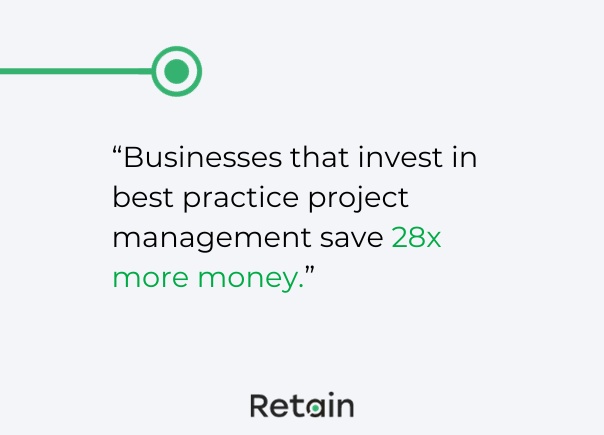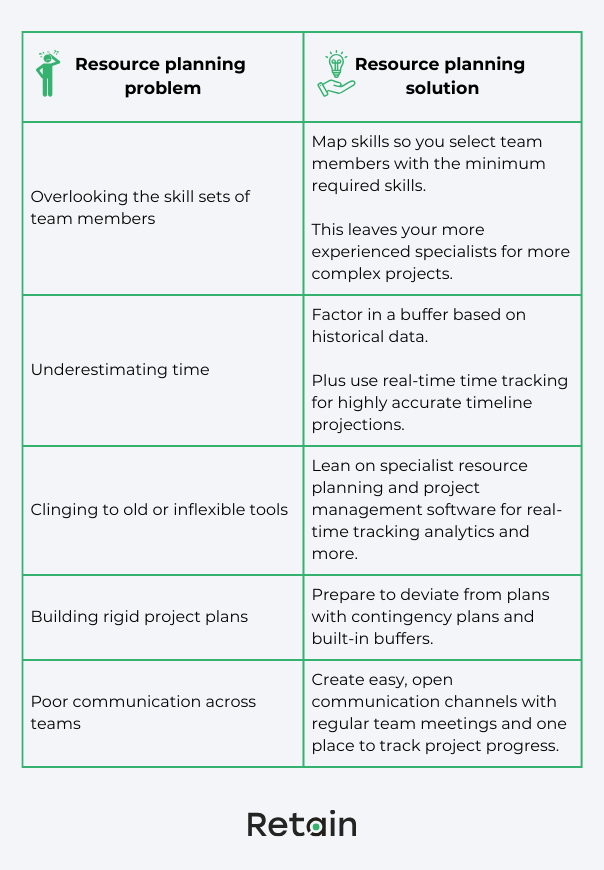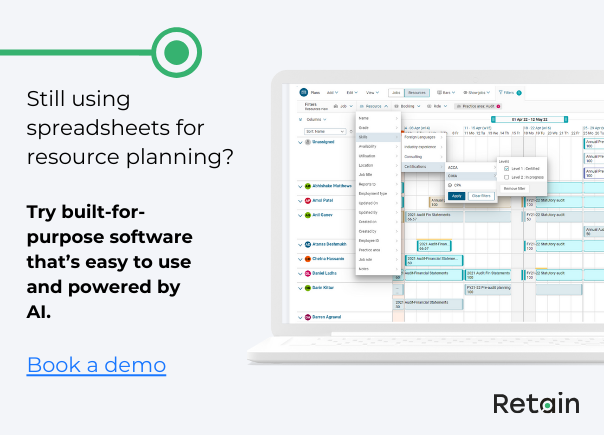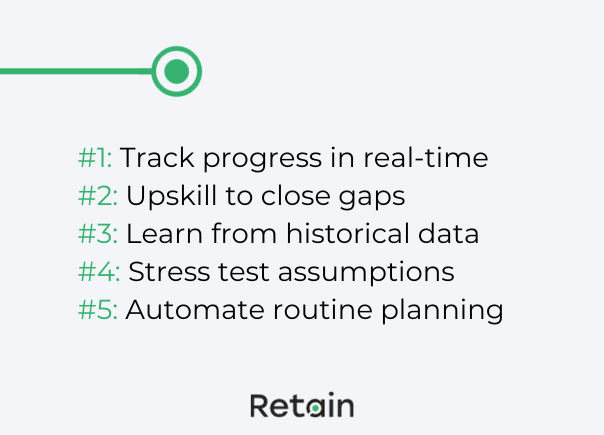Resource planning in project management literally makes or breaks any service-based business. That’s because maximising resources – namely your people – directly boosts profit margins.
Why? Identifying the right resources and optimising time streamlines operations, cuts waste, and ensures quality service. In fact, best practice project management saves 28x more money (CIO*). That’s a hard stat to ignore.
With this in mind, in this blog, we’ll delve into proven resource planning practices with tips to overcome challenges and actually boost efficiency and profit.

Common resource planning blockers
Even the best-laid plans hit challenges. When planning resources, these are the most common bottlenecks:
❌ #1: Unexpected resource conflicts
When multiple projects run at the same time, there’s likely cross-over with the specialists needed. And even with the most informed planning, demand for the same resources creates a bottleneck.
Why it’s common: This happens more frequently in businesses that have multiple project managers using the same resources.
❌ #2: Priority changes and timelines drift
Of course, we would like every project to run according to timelines. But, sometimes, factors like client demands and market changes are unforeseeable and have a knock-on effect on plans.
Why it’s common: When both your business and your clients are impacted by so many factors outside of your control – economic changes, stakeholders' interest, technology updates, and more – priorities can change instantly and plans need to pivot.
❌ #3: Communication breakdowns
This is a major cause of leaking money. Without open and regular communication across teams, resources are often wasted and projects can get delayed.
Why it’s common: With multiple stakeholders involved, liaising on schedules, constraints and budgets is a tall order. Naturally, this increases the likelihood of mishaps.
So, how can project management navigate these issues? Let’s break these challenges down further to unpack solutions. ?
Problem vs solution: How to overcome resource planning issues
Resource planning in project management is crucial yet challenging. Without proper planning, projects can quickly go over budget, fall behind schedule, or deliver disappointing results. Common resource planning pitfalls include underestimating timelines, assigning the wrong team members, poor communication, and rigid planning.
Thankfully, there are solutions to these common problems. With the right approach, you can overcome resource planning challenges and set your projects up for success. The table below outlines some typical resource planning issues along with fixes to help optimise your workflow, timelines, budgets, and resource allocation:

Now, let’s delve into some of the more advanced resource planning in project management best practices used by leading service-based businesses…
5 resource planning in project management best practices
It’s a simple equation: Optimising the use of resources = more projects scheduled with precision and greater profit margins. So, how exactly do market leaders boost efficiency – whilst preventing staff burnout?
Let’s look at the top strategies organisations rely on for smooth resource planning in project management.
? #1: Track progress in real-time
Successful project management relies on vigilant budget monitoring and tracking resources. But as things change, plans will too and that’s why it's important to regularly review progress.
And this is where real-time tracking comes in. If you can track resource and project performance live, you can see when timelines start to slip or new priorities require an adjustment. This means you can plug resource gaps, resolve issues, and keep tasks on track with SLAs, and within budget.
What’s more, real-time data makes for more accurate financial forecasting too.

? #2: Upskill your team to close skills gaps
If team members don’t have the required skills to complete projects, you’ll get hit with delays, poor customer experience, the inability to pitch for new projects or additional client requests – and worse. Likewise, if you’ve only got the most senior team members working on every project, profit margins have little flexibility.
With so many industries hit with skills shortages, hiring more people isn’t always an option. And let’s face it, it adds to overheads too, which can be risky. So, building skills internally based on upcoming projects or gaps within the team’s knowledge helps to prepare. This may be training them with a new piece of tech, for example.
Having a central repository of employee skills can significantly help with this. Some resource management platforms include this feature as standard.
? #3: Learn from historical data
Real-time data helps you see how the business is performing right now. But past experiences help with planning. For example, historic data can shed light on:
- Where resources are over or under-allocated
- How much time and budget tasks actually use (and how this changes over time with inflation etc.)
- Which clients require more time than budgeted
And so much more. All of this helps to prepare but also to quote and charge correctly, as well as prevent mishaps which can be demotivating for the team and worse case, could result in a negative client experience.
? #4: Stress test assumptions
While project plans rely heavily on historical data and what’s expected to happen, this only acts as a gauge. The length of time tasks take, the cost and the specialists required all hang in the balance.
Successful project managers validate assumptions with the specialists assigned, particularly those who have worked with the client and know the internal politics involved. This allows them to question estimates and more accurately benchmark costs – which could otherwise eat into profits.
Moreover, in some industries, tasks can be benchmarked against industry standards.
? #5: Automate routine planning
There are specialist tools dedicated to resource planning that take the stress out of project management. For example, Retain can help you to quickly review existing skill sets, along with locations and priorities, to pull together the perfect team. On top of this, it can track performance in real-time.
Not only does this allow for speed and efficiency, but it also reduces errors and administration – freeing up team members to work on other business areas like new business or strategic oversight.
⏱ Quick summary
We’ve covered quite a few tips here so let’s pull it all together…
Ultimately, resource planning should be considered an ongoing process that leverages both historic data – in the early days of planning – and real-time data to create a live, active view of resource planning in project management.
Plans should be stress-tested to validate assumptions and then allow you to build in buffers. And technology can make this whole process much quicker and smoother – while providing all team members with insight to ease communication challenges.
⚡Combined, all this adds to seamless resource management and significant profitability gains that leadership notices.

Increase efficiency with best practice resource planning in project management
To grow revenue, resource planning is critical because it enables optimised use of the most precious and limited assets: time, talent, and budget.
And it’s particularly essential for businesses that:
- Are susceptible to demand fluctuations
- Share resources across multiple teams
- Have specialists as the core revenue-generator (there is no product line to support revenue)
- Struggle with a skills shortage within the industry – so hiring additional people isn’t an option
Following these resource planning best practices not only works around common challenges like fluctuating demand, it also reduces the likelihood of delayed projects, which impact client experiences.
The end result? Boosts profit margins through lower costs and greater revenue by maximising the use of resources. All while keeping your employees and clients happy.
Ready to boost your bottom line? See how our resource planning software can help. Book a demo here now.
Or if you're looking for more insights, you'll love these:
?8 resource allocation best practices for a human-centred approach
?The future of resource management: 6 trends for 2024
?Understanding AI in resource management
Source: https://www.workamajig.com/blog/project-management-statistics


